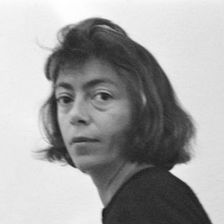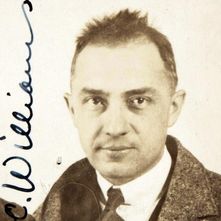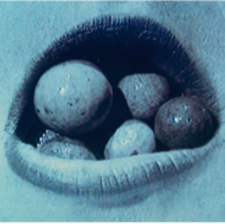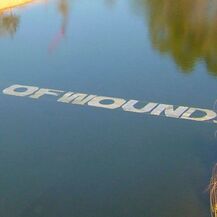Selected Articles
Poets & Poetry Publications

“An Aquatic Reverie” | Mallarmé’s Writing on Water and the Naming of Waves
Journal of Foreign Languages and Cultures (Dec. 2019). Vol. 3, No. 2: 55-63.
At his home outside Paris, in Valvin, Stéphane Mallarmé spent much time on his small boat dreamily sailing upon the Seine, seeing this body of flowing water as a site for inspiration and inscription. Indeed, Mallarmé once confided to a friend, “I no longer write a poem without an aquatic reverie running through it,” and that, for him, poetry was like an “oar stroke,” and the sail, a “white page”.... Read More
(Click here for photographs and video of related Oxford "writing on water" installation)
Journal of Foreign Languages and Cultures (Dec. 2019). Vol. 3, No. 2: 55-63.
At his home outside Paris, in Valvin, Stéphane Mallarmé spent much time on his small boat dreamily sailing upon the Seine, seeing this body of flowing water as a site for inspiration and inscription. Indeed, Mallarmé once confided to a friend, “I no longer write a poem without an aquatic reverie running through it,” and that, for him, poetry was like an “oar stroke,” and the sail, a “white page”.... Read More
(Click here for photographs and video of related Oxford "writing on water" installation)

Reinventing Language, Vowel by Colorful Vowel
Five Points: A Journal of Literature and Art (Fall 2014). Vol. 16, No. 2: 104-111.
After he’d invented “the color of vowels,” regulated the “form and movement of each consonant,” the young poet then, applying his “instinctive rhythms” to the task, proudly proclaimed that he had alchemically created “a poetic language accessible, some day, to all the senses.” Notably, with his project in place, this poet, Arthur Rimbaud, tells us that he was then quick to “reserve translation rights” .... Read More
Five Points: A Journal of Literature and Art (Fall 2014). Vol. 16, No. 2: 104-111.
After he’d invented “the color of vowels,” regulated the “form and movement of each consonant,” the young poet then, applying his “instinctive rhythms” to the task, proudly proclaimed that he had alchemically created “a poetic language accessible, some day, to all the senses.” Notably, with his project in place, this poet, Arthur Rimbaud, tells us that he was then quick to “reserve translation rights” .... Read More

That’s the Beauty of It, Or, Why John Ashbery is Not a Painter
Journal of Modern Literature. 34: 4 (Summer 2011): 172-184.
Picturing a poet as a painter, a painter as a poet, can be of some real value in reading a poem and in looking at a painting. After all, the one has often acknowledged, or even embraced, the other as an influence, an inspiration, a guide of sorts through the landscape of language, the language of color and form. To see words where there is paint, paint where there are words, might thus offer a kind of frame or focus... Read more
(Click here for photographs of related Paris "writing on air" installation)
Journal of Modern Literature. 34: 4 (Summer 2011): 172-184.
Picturing a poet as a painter, a painter as a poet, can be of some real value in reading a poem and in looking at a painting. After all, the one has often acknowledged, or even embraced, the other as an influence, an inspiration, a guide of sorts through the landscape of language, the language of color and form. To see words where there is paint, paint where there are words, might thus offer a kind of frame or focus... Read more
(Click here for photographs of related Paris "writing on air" installation)

So Much Depends: Printed Matter, Dying Words and the Entropic Poem
Critical Inquiry 30: 3 (Spring 2004): 627-653.
Growing up in Rutherford, New Jersey, in the 1940s, Robert Smithson would periodically visit his pediatrician, William Carlos Williams, who had his home and medical practice across town at Nine Ridge Road. There were, no doubt, the routine checkups, the childhood ailments and inoculations, the doctor looking into the mouth, the ears, the eyes of the little boy.....Read more
Critical Inquiry 30: 3 (Spring 2004): 627-653.
Growing up in Rutherford, New Jersey, in the 1940s, Robert Smithson would periodically visit his pediatrician, William Carlos Williams, who had his home and medical practice across town at Nine Ridge Road. There were, no doubt, the routine checkups, the childhood ailments and inoculations, the doctor looking into the mouth, the ears, the eyes of the little boy.....Read more
Music Publications

Departing Landscapes: Morton Feldman’s String Quartet II and Triadic Memories
SubStance 110. 35: 2 (Summer 2006): 17-50.
In the summer of 1996, the Kronos Quartet was scheduled to present Morton Feldman’s String Quartet II (1983) at the Lincoln Center Festival in New York. The performance was being promoted as the centerpiece of a much large Feldman tribute and retrospective that was to go on for several days. Feldman's legendary quartet had never before been given in its entirety, which, if faithfully done would last, uninterrupted, around six hours......Read more
SubStance 110. 35: 2 (Summer 2006): 17-50.
In the summer of 1996, the Kronos Quartet was scheduled to present Morton Feldman’s String Quartet II (1983) at the Lincoln Center Festival in New York. The performance was being promoted as the centerpiece of a much large Feldman tribute and retrospective that was to go on for several days. Feldman's legendary quartet had never before been given in its entirety, which, if faithfully done would last, uninterrupted, around six hours......Read more

Suspicious Silence: Walking Out on John Cage
Current Musicology, 94 (Fall 2012): 127-142
2012 marked what would have been the composer and writer John Cage’s 100th birthday, offering a nice round numbered moment to commemorate and reevaluate Cage’s lasting legacy. And it is
a rich and still, astonishingly, controversial legacy, bringing forth bold assessments of Cage that range, as they have for decades, from worshipful acclaim, to ridiculing rejection.... Read More
(Click here for photographs of related "writing on water | writing on air" installation)
Current Musicology, 94 (Fall 2012): 127-142
2012 marked what would have been the composer and writer John Cage’s 100th birthday, offering a nice round numbered moment to commemorate and reevaluate Cage’s lasting legacy. And it is
a rich and still, astonishingly, controversial legacy, bringing forth bold assessments of Cage that range, as they have for decades, from worshipful acclaim, to ridiculing rejection.... Read More
(Click here for photographs of related "writing on water | writing on air" installation)
Theater, Performance & Installation Art Publications

Antonin Artaud's Unending Death Rattle
Rattle: A Journal at the Convergence of Art and Writing. Vol. 3 (Summer 2012): 27-40.
1924: In his book, The Secret Art of Antonin Artaud, Jacques Derrida examines Artaud’s complex and enduring legacy as both a writer and artist, insisting that “...we have to learn not to be in a hurry to seize, to understand, we have to give the ink of so many words depositing themselves slowly in the thickness of the body time to get absorbed” (71). A question arising from Derrida’s plea for a kind of hermeneutic patience is whether now—well into the 21st century—enough time has yet passed for the “ink of so many of [Artaud’s] words” to have been “absorbed,” his words deposited upon the “thickness” of his dead body, rattling still in their turbulent decay....Read more
Rattle: A Journal at the Convergence of Art and Writing. Vol. 3 (Summer 2012): 27-40.
1924: In his book, The Secret Art of Antonin Artaud, Jacques Derrida examines Artaud’s complex and enduring legacy as both a writer and artist, insisting that “...we have to learn not to be in a hurry to seize, to understand, we have to give the ink of so many words depositing themselves slowly in the thickness of the body time to get absorbed” (71). A question arising from Derrida’s plea for a kind of hermeneutic patience is whether now—well into the 21st century—enough time has yet passed for the “ink of so many of [Artaud’s] words” to have been “absorbed,” his words deposited upon the “thickness” of his dead body, rattling still in their turbulent decay....Read more

Wiping Blood from the Walls: Medea’s Pleasures of Terror
Theatre Topics 16: 1 (March 2006): 35-45.
I was there and then I wasn’t. The actors were before me and then they weren’t. The curtain opened, it closed, and—in the play of appearances and disappearances—something was seen in the vanishings. Remaining, what I now write is a kind of a recollected narrative, a reportorial account of British director Deborah Warner’s recent adaptation of Euripides’ Medea. As a member of its audience one evening, I look back from the strict vantage of the remembered event, from the dual perspective of having seen the performance, but of seeing it no longer....Read more
Theatre Topics 16: 1 (March 2006): 35-45.
I was there and then I wasn’t. The actors were before me and then they weren’t. The curtain opened, it closed, and—in the play of appearances and disappearances—something was seen in the vanishings. Remaining, what I now write is a kind of a recollected narrative, a reportorial account of British director Deborah Warner’s recent adaptation of Euripides’ Medea. As a member of its audience one evening, I look back from the strict vantage of the remembered event, from the dual perspective of having seen the performance, but of seeing it no longer....Read more

“Staring Sightlessly": Proust’s Presence in Beckett’s Absence
Journal of Dramatic Theory and Criticism 22: 1 (Fall 2007): 53-63.
Act Three: It begins and ends with boots, straining to remove them, and a pleading finally for someone to come, for someone to care; Estragon, in Samuel Beckett’s Waiting for Godot, calls
out ‘feebly’ to Vladimir, ‘Help me!’ But as the playwright’s critical stage directions then instruct, Estragon ‘gives up, exhausted, rests, tries again. As before’. Finally he concludes, there at the very start of the play, there at the boots – ‘pull[ing] […] with both hands, panting’ – where nothing has begun, that there is ‘Nothing to be done’.....Read more
Journal of Dramatic Theory and Criticism 22: 1 (Fall 2007): 53-63.
Act Three: It begins and ends with boots, straining to remove them, and a pleading finally for someone to come, for someone to care; Estragon, in Samuel Beckett’s Waiting for Godot, calls
out ‘feebly’ to Vladimir, ‘Help me!’ But as the playwright’s critical stage directions then instruct, Estragon ‘gives up, exhausted, rests, tries again. As before’. Finally he concludes, there at the very start of the play, there at the boots – ‘pull[ing] […] with both hands, panting’ – where nothing has begun, that there is ‘Nothing to be done’.....Read more

Soliloquies of Silence: James Turrell's Theatre of Installation
Mosaic: A Journal for the Interdisciplinary Study of Literature 37: 1 (March 2009): 85-98
If the darkness of James Turrell’s installation had radically covered my eyes, instantly blinding me to the space in which I stood, it was that same darkness that—as if in perceptual compensation for the loss—had incited my mind to speak and think into the dark, seeking a kind of reassuring orientation from within its absence. ....Read more
Mosaic: A Journal for the Interdisciplinary Study of Literature 37: 1 (March 2009): 85-98
If the darkness of James Turrell’s installation had radically covered my eyes, instantly blinding me to the space in which I stood, it was that same darkness that—as if in perceptual compensation for the loss—had incited my mind to speak and think into the dark, seeking a kind of reassuring orientation from within its absence. ....Read more

Theater as Installation: Ann Hamilton and the Accretions of Gesture
Mosaic: A Journal for the Interdisciplinary Study of Literature 37: 1 (March 2004): 119-133.
Entering a large gallery space in what was once an old warehouse, we see near the center of the room a young woman sitting alone at a small metal table, a book open before her. The floor of the gallery is covered in thick bundles of dark horsehair that have been scattered evenly throughout the entire room and a muted sunlight comes in through large, translucent windows ....Read more
Mosaic: A Journal for the Interdisciplinary Study of Literature 37: 1 (March 2004): 119-133.
Entering a large gallery space in what was once an old warehouse, we see near the center of the room a young woman sitting alone at a small metal table, a book open before her. The floor of the gallery is covered in thick bundles of dark horsehair that have been scattered evenly throughout the entire room and a muted sunlight comes in through large, translucent windows ....Read more

The Theater and its Derridean Double: Writing Upon Theaters of Thought
Rhizomes: Cultural Studies in Emerging Knowledge (Winter 2008).
The problem with the reading is the writing. For the words are only there as long as you see them there. The book closes and the words are gone. "Now you see them; now you don't." Like magic. Or like actors on a stage, the printed words perform only while the curtain, while the book, is open. Otherwise, they lie dumbly and unseen between the closed or curtained covers....Read more
Rhizomes: Cultural Studies in Emerging Knowledge (Winter 2008).
The problem with the reading is the writing. For the words are only there as long as you see them there. The book closes and the words are gone. "Now you see them; now you don't." Like magic. Or like actors on a stage, the printed words perform only while the curtain, while the book, is open. Otherwise, they lie dumbly and unseen between the closed or curtained covers....Read more

“(Silence): Scripting [It], Staging [It] on the Page, For the Stage.”
Journal of Dramatic Theory and Criticism 15: 2 (Spring 2001): 69-84.
The stage is no place for silence. The silence is no place for a stage. Like a white page upon which it is inscribed, presented as dramatic instruction — "(siience)" — the word is made into a mark, made into a bracketed moment, only to be instantly, noisily transformed into utterance....Read more
Journal of Dramatic Theory and Criticism 15: 2 (Spring 2001): 69-84.
The stage is no place for silence. The silence is no place for a stage. Like a white page upon which it is inscribed, presented as dramatic instruction — "(siience)" — the word is made into a mark, made into a bracketed moment, only to be instantly, noisily transformed into utterance....Read more
Writing On Water Publications

Writing on Basho's Pond
Critical Multilingualism Studies. 7: 2 (2019): 21-34.
Matsuo Basho is Japan’s most well-known and well-respected haiku poet; and Basho’s poem
about the old pond, the jumping frog, and the sound of water is perhaps Basho’s best-known
haiku. Indeed, this haiku, like Basho himself, is known well beyond Japan, long ago attaining
through its many translations a degree of international recognition..... Read More
(Click here for photographs and video of the Tama Art University installation)
Critical Multilingualism Studies. 7: 2 (2019): 21-34.
Matsuo Basho is Japan’s most well-known and well-respected haiku poet; and Basho’s poem
about the old pond, the jumping frog, and the sound of water is perhaps Basho’s best-known
haiku. Indeed, this haiku, like Basho himself, is known well beyond Japan, long ago attaining
through its many translations a degree of international recognition..... Read More
(Click here for photographs and video of the Tama Art University installation)

Bodies of Water: Somebody | Nobody (For E.D.)
Emily Dickinson International Society Bulletin. 27: 2 (Nov./Dec. 2015): 16-20.
On a pond adjacent to the University of North Florida’s Thomas G. Carpenter Library,
parts of Emily Dickinson’s well-known poem about being a “Nobody” were recently written on the water. During the fall of 2014, the familiar words of that poem’s opening line — “I’m Nobody! Who are you?” — appeared to float upon the library’s pond, reflecting vividly in the light of day (yet disappearing entirely in the dark of night)...... Read More
(Click here for photographs of related UNF "writing on water | writing on air" installation)
Emily Dickinson International Society Bulletin. 27: 2 (Nov./Dec. 2015): 16-20.
On a pond adjacent to the University of North Florida’s Thomas G. Carpenter Library,
parts of Emily Dickinson’s well-known poem about being a “Nobody” were recently written on the water. During the fall of 2014, the familiar words of that poem’s opening line — “I’m Nobody! Who are you?” — appeared to float upon the library’s pond, reflecting vividly in the light of day (yet disappearing entirely in the dark of night)...... Read More
(Click here for photographs of related UNF "writing on water | writing on air" installation)

Writing on Water, Murmur of Words
New Writing: Journal for the Practice & Theory of Creative Writing, 7: 2 (Fall 2010): 139-159.
To date, there have been three different ‘writing on water’ installations completed on the pond adjacent to the university's library. When first conceived, this project was largely hypothetical and theoretical, proposed almost on a whim as a part of a course that I was teaching on concrete and visual poetry. However, once the idea for such a project was presented, it seemed that its implementation had to be attempted, even if it were finally to fail.... Read More
(Click here for photographs of related "writing on water | writing on air" installation)
New Writing: Journal for the Practice & Theory of Creative Writing, 7: 2 (Fall 2010): 139-159.
To date, there have been three different ‘writing on water’ installations completed on the pond adjacent to the university's library. When first conceived, this project was largely hypothetical and theoretical, proposed almost on a whim as a part of a course that I was teaching on concrete and visual poetry. However, once the idea for such a project was presented, it seemed that its implementation had to be attempted, even if it were finally to fail.... Read More
(Click here for photographs of related "writing on water | writing on air" installation)

Seeing In Plain Sight—Installations in Flight
University of Toronto Quarterly. 83: 3 (Fall 2014): 606-624.
An installation, art or otherwise, offers a determined point of view, a specific positioning by which something is intended to be specifically seen, engaged, and thought about, thought through. A separation or isolation is established by which a setting, a situation, an action, or an event has been set apart in order to be entered into, seen differently.... Read More
(Click here for photographs of related Toronto "writing on air" installation)
University of Toronto Quarterly. 83: 3 (Fall 2014): 606-624.
An installation, art or otherwise, offers a determined point of view, a specific positioning by which something is intended to be specifically seen, engaged, and thought about, thought through. A separation or isolation is established by which a setting, a situation, an action, or an event has been set apart in order to be entered into, seen differently.... Read More
(Click here for photographs of related Toronto "writing on air" installation)
Robert Smithson Publications

So Much Depends: Printed Matter, Dying Words and the Entropic Poem
Critical Inquiry 30: 3 (Spring 2004): 627-653.
Growing up in Rutherford, New Jersey, in the 1940s, Robert Smithson would periodically visit his pediatrician, William Carlos Williams, who had his home and medical practice across town at Nine Ridge Road. There were, no doubt, the routine checkups, the childhood ailments and inoculations, the doctor looking into the mouth, the ears, the eyes of the little boy.....Read more
Critical Inquiry 30: 3 (Spring 2004): 627-653.
Growing up in Rutherford, New Jersey, in the 1940s, Robert Smithson would periodically visit his pediatrician, William Carlos Williams, who had his home and medical practice across town at Nine Ridge Road. There were, no doubt, the routine checkups, the childhood ailments and inoculations, the doctor looking into the mouth, the ears, the eyes of the little boy.....Read more

Quiet Catastrophe: Robert Smithson’s Spiral Jetty, Vanished
Discourse 24.2 (Spring 2002): 84-118.
Maps to Nowhere: Seen from above, Robert Smithson’s Spiral Jetty emerges dramatically from the rocky shores of Utah’s Great Salt Lake. Like a swirling vortex steadied and then stilled, the earthwork begins as a straight line of stone extending far into the water, the form then curving, arching and coiling in upon itself until abruptly coming to an end....Read more
(Click here for photographs of Spiral Jetty, vanished)
Discourse 24.2 (Spring 2002): 84-118.
Maps to Nowhere: Seen from above, Robert Smithson’s Spiral Jetty emerges dramatically from the rocky shores of Utah’s Great Salt Lake. Like a swirling vortex steadied and then stilled, the earthwork begins as a straight line of stone extending far into the water, the form then curving, arching and coiling in upon itself until abruptly coming to an end....Read more
(Click here for photographs of Spiral Jetty, vanished)

Robert Smithson’s Enantiomorphic Chambers and the Exhibition of Absence
In (Im)permanence: Cultures in/out of Time. Penn State UP, 2008: 59-69.
At first glance, outside of the defining context of a gallery or an art book, Robert Smithson's Enantiomorphic Chambers looks less like a sculpture, and more like a crude instrument or a makeshift machine of some kind, one that is to be put to use, activated by our engagement; standing between the separate sections, it seems the geometric chambers are to be examined, the mirrors looked within ..... Read more
In (Im)permanence: Cultures in/out of Time. Penn State UP, 2008: 59-69.
At first glance, outside of the defining context of a gallery or an art book, Robert Smithson's Enantiomorphic Chambers looks less like a sculpture, and more like a crude instrument or a makeshift machine of some kind, one that is to be put to use, activated by our engagement; standing between the separate sections, it seems the geometric chambers are to be examined, the mirrors looked within ..... Read more
Japan Publications

Writing on Basho's Pond
Critical Multilingualism Studies. 7: 2 (2019): 21-34.
Matsuo Basho is Japan’s most well-known and well-respected haiku poet; and Basho’s poem about the old pond, the jumping frog, and the sound of water is perhaps Basho's best-known haiku. Indeed, this haiku, like Basho himself, is known well beyond Japan, long ago attaining through its many translations a degree of international recognition..... Read More
(Click here for photographs and video of the Tama Art University installation)
Critical Multilingualism Studies. 7: 2 (2019): 21-34.
Matsuo Basho is Japan’s most well-known and well-respected haiku poet; and Basho’s poem about the old pond, the jumping frog, and the sound of water is perhaps Basho's best-known haiku. Indeed, this haiku, like Basho himself, is known well beyond Japan, long ago attaining through its many translations a degree of international recognition..... Read More
(Click here for photographs and video of the Tama Art University installation)

Picturing the Flames of Daimonji
Kyoto Journal (Winter 2015). 84: 20-33.
As the fires were burning on top of the mountain, I saw before me the woman holding out the photograph, the picture in her hands set against the flames. With one arm outstretched and the other clasping her camera, she then proceeded to take a photograph of the photograph that she held tightly, the tall fires burning just a few feet in front of her.... Read More
(Click here for photographs of Kyoto's Daimonji Festival)
Kyoto Journal (Winter 2015). 84: 20-33.
As the fires were burning on top of the mountain, I saw before me the woman holding out the photograph, the picture in her hands set against the flames. With one arm outstretched and the other clasping her camera, she then proceeded to take a photograph of the photograph that she held tightly, the tall fires burning just a few feet in front of her.... Read More
(Click here for photographs of Kyoto's Daimonji Festival)

Dance of Light and Loss
Performing Arts Journal (Summer 2016). Vol. 38, No. 1: 56-62.
On a bright and sunny Sunday afternoon in the Ogikubo district of western Tokyo, in the dark basement of Saburo Teshigawara’s dance studio and performance space known as Karas Apparatus, an audience gathered to see the dancer’s newest solo performance, Fool. The uncurtained stage in the small theatre was empty and unlit, the stage itself far larger, perhaps
three times larger than that tight space reserved for those attending the event .... Read More
Performing Arts Journal (Summer 2016). Vol. 38, No. 1: 56-62.
On a bright and sunny Sunday afternoon in the Ogikubo district of western Tokyo, in the dark basement of Saburo Teshigawara’s dance studio and performance space known as Karas Apparatus, an audience gathered to see the dancer’s newest solo performance, Fool. The uncurtained stage in the small theatre was empty and unlit, the stage itself far larger, perhaps
three times larger than that tight space reserved for those attending the event .... Read More

Broken English: Deviant Language and the Para-Poetic
Kyoto Journal 29 (Spring 1995): 90-99.
“You don’t yourself until now from tomorrow.” Forming a part of a paragraph describing a dream,
the above sentence is an example of the kind of writing frequently encountered in the teaching of English as a foreign language. Non-native students of English will often speak and write in ways that, in addition to being technically incorrect, seem both peculiar and provocative to the native speaker.... Read more
Kyoto Journal 29 (Spring 1995): 90-99.
“You don’t yourself until now from tomorrow.” Forming a part of a paragraph describing a dream,
the above sentence is an example of the kind of writing frequently encountered in the teaching of English as a foreign language. Non-native students of English will often speak and write in ways that, in addition to being technically incorrect, seem both peculiar and provocative to the native speaker.... Read more

East Meets West Meets East: Dreaming Japanese Butoh
In The Avant-garde and the Margins: . Cambridge: Cambridge Scholars Press, 2006.
I came to Butoh by videotape. Or rather, my earliest real awareness of this contemporary dance/theater movement from Japan came by way of a documentary about it that a friend showed me one evening, several years ago, while sitting in his living room in Hiroshima, Japan. The scenes, images and interviews that I encountered in that film were so immediately striking and strange that my fascination with Butoh was instantly engaged....Read more
In The Avant-garde and the Margins: . Cambridge: Cambridge Scholars Press, 2006.
I came to Butoh by videotape. Or rather, my earliest real awareness of this contemporary dance/theater movement from Japan came by way of a documentary about it that a friend showed me one evening, several years ago, while sitting in his living room in Hiroshima, Japan. The scenes, images and interviews that I encountered in that film were so immediately striking and strange that my fascination with Butoh was instantly engaged....Read more

The Philosopher and the Geisha
Discourse 22.2 (Spring 2000): 92-103.
On January 20, 1997, the philosopher Alphonso Lingis walked onto the darkened, prefabricated
stage of an art gallery in downtown Kyoto to perform a reading entitled "The Religion of Animals." Dressed in full kimono, impeccably presented in the traditional manner of the Japanese Geisha, Lingis stopped and stood before the gathered audience, his face and neck covered in white
makeup, his lips carefully and richly outlined in vivid red, and atop his head was a full black wig
from which various hair ornaments dangled and glimmered. ....Read more
Discourse 22.2 (Spring 2000): 92-103.
On January 20, 1997, the philosopher Alphonso Lingis walked onto the darkened, prefabricated
stage of an art gallery in downtown Kyoto to perform a reading entitled "The Religion of Animals." Dressed in full kimono, impeccably presented in the traditional manner of the Japanese Geisha, Lingis stopped and stood before the gathered audience, his face and neck covered in white
makeup, his lips carefully and richly outlined in vivid red, and atop his head was a full black wig
from which various hair ornaments dangled and glimmered. ....Read more
Copyright © 2021 Clark Lunberry. All rights reserved.